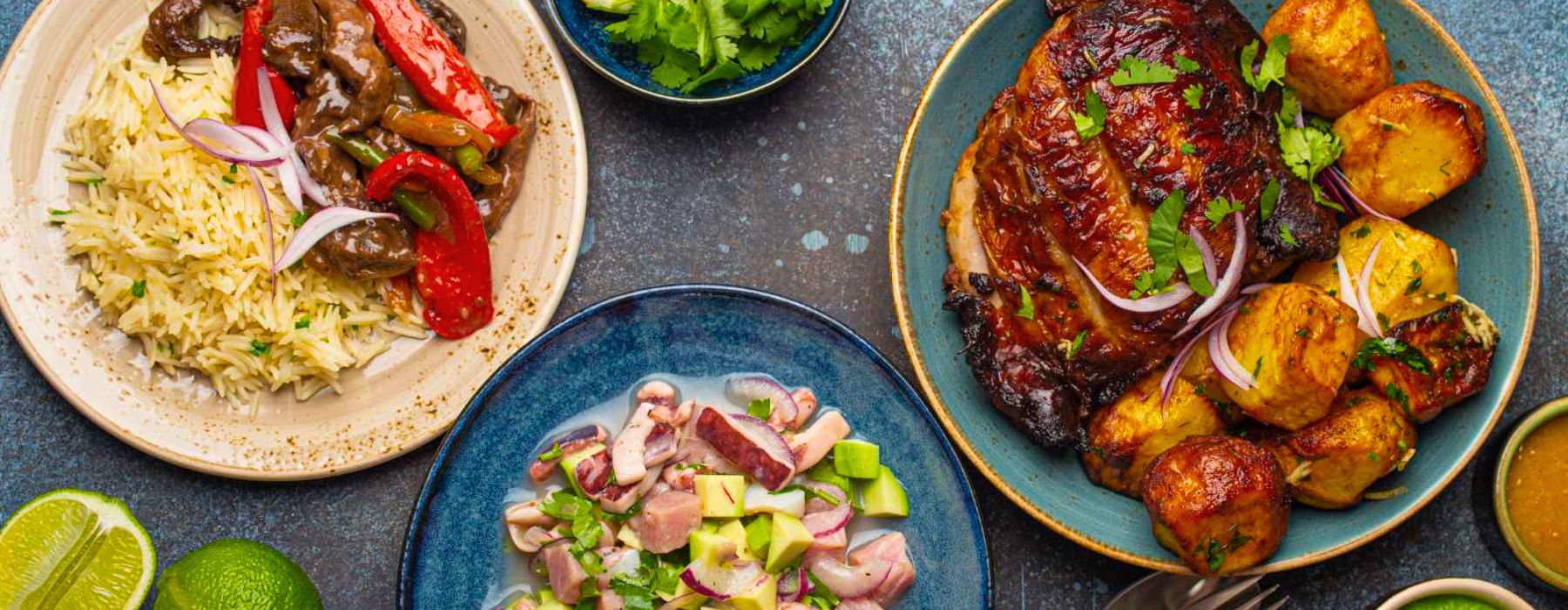
The richness of its lands and its cultural diversity make Peru a country of exquisite and varied gastronomy. Each city has a typical dish with an incomparable flavor. Thousands of farm products and dozens of living cultures that have shared a single territory for centuries, ended up creating an infinite offer for the palate. Peruvian cuisine is a celebration of Peru. A country with an ancient tradition and a promising future that does not lose sight of its roots and where the art of good food stands out among its inhabitants as one of the most distinctive signs of its identity.
The Peruvian people is famous for its demanding and refined palate, which comes from time immemorial. Pre-Columbian techniques allowed the preparation of soups, stews and raw fish. Food processing was a common part of daily life, having knowledge of salting meat, dehydrating and cooking in natural earth ovens. With Spanish colonization, together with African, Chinese, Italian and Japanese migration, Peruvian cuisine embraced different ways of seeing the world and new preparation techniques. The influence of Spain and China stands out, which originated gastronomy with its own name: Creole food and chifa, respectively.
Peruvian gastronomy is the set of dishes and culinary techniques of Peru that are part of the traditions and common life of its inhabitants, the result of the fusion of the culinary tradition of ancient Peru with European and other gastronomy. In 2011, Peruvian gastronomy was recognized as “Cultural Heritage of the Americas for the World” by the Organization of American States. Peruvian cuisine is one of the most important cuisines in the world and an example of fusion cuisine, due to its long multicultural history, which is based on the mixture of the culinary knowledge of ancient Peru with its own techniques and stews.
Peruvian cuisine is one of the most varied in the world; the book 357 lists to understand how we Peruvians are counts up to 491 typical dishes, being the gastronomy with the most typical dishes in the world. Along the Peruvian coast there are more than two thousand five hundred different types of soups, as well There are also more than 250 traditional desserts. The great variety of Peruvian cuisine is based on three sources: the particularity of Peru’s geography, the mixture of cultures, and the adaptation of ancient cultures to modern cuisine.
Peru is the country with the greatest variety of potatoes worldwide, with more than three thousand types of potatoes, which, in fact, has its origins in the southern highlands of Peru, a tuber that plays a very important role in global gastronomy , and in world cuisine. Some important Peruvian dishes that use potatoes are: huancaína-style potatoes, stuffed potatoes, Lima-style causes, etc.
Lima, the capital of Peru, is recognized as the gastronomic capital of America. One of the reasons why it is called this way is because it has the most important food festival in Latin America, the International Gastronomic Fair of Lima, known as Mistura.
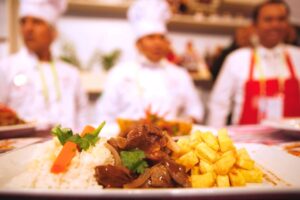
The presence of the various altitudinal floors of the Andes mountain range in Peru and its proximity to the geographic equator allow the existence of a series of microclimates and species, from areas with regular snowfall to tropical forests; With 84 of the 104 climate zones on the globe, it is one of the 12 countries in the world with the greatest mega diversity. It has suitable conditions for the cultivation of fruits and vegetables throughout the year. Likewise, the Humboldt current of cold oceanic waters that run through the Pacific Ocean off the Peruvian coast allows the existence of a great variety of fish and shellfish (Peru is one of the main fishing countries in the world).
The central Peruvian Andes were the largest center of plant domestication in the ancient world, with native species such as maize, tubers with more than seven thousand varieties of potato, according to the National Institute of Agrarian Innovation (INIA), and many other sweet potatoes. , cassava or cassava, oca, maca; grasses, quinoa, kiwicha or amaranth, cañihua; fruits such as custard apple, lucuma, pacae, tomato, pumpkin, avocado, tumbo, elderberry; tales of legumes such as beans, pallares, peanuts and a wide variety of aromatic herbs.
Before the arrival of the Europeans, the Peruvian geography was home to a great variety of cultures, all conquered by the Inca Empire, each of which had particular gastronomic characteristics, there were some generalities, according to the chroniclers of the Conquest. For example, the main condiments were aromatic herbs, cocha yuyo (a type of river algae), salt, and above all, chili pepper, called uchu in Quechua, and today considered a fundamental element of Peruvian cuisine.
The Inca Garcilaso de la Vega in his Royal Commentaries wrote about it:
“Those from my land are such friends of uchu, that they will not eat without it, even if it is nothing but raw herbs. Because of the taste they receive from what they eat, they forbade eating it in their rigorous fasting, because it would be more rigorous. ”
It was common to prepare food in dehydrated form, to avoid its decomposition, emphasizing jerky, salted meat, and caui, which is sun-dried goose. The ancient Peruvians also consumed immense quantities of fish and shellfish (the archaeological record of this is overwhelming) and supplemented their diet with duck meat, guinea pig and domestic South American camelids (mainly alpaca and llama).
In the societies of the north coast, in addition, the meat of certain lizards and deer was consumed. In those of the eastern jungle they fed on the multitude of species provided by the Amazonian flora and fauna. Since millenary times, the ancient Peruvians prepared chupes or alone, stews (carapulcra, for example, is considered the oldest type of Peruvian stew), made stews with raw marine species marinated with chili, tumbo and herbs, from which the ceviche that in pre-Columbian times had another name in Quechua.
They had different ways of processing food, they salted fish, roasted corn (obtaining the cancha, which is the simplest and most popular Peruvian “piqueo” to this day) or peeled their grains and dried them (obtaining a nickname). Likewise, they prepared jerky or stuffed, salted and frayed camelid meat, different types of chuño, tubers dried and frozen outdoors. They cooked in clay pots and, on occasion, organized large banquets of meat and vegetables from natural earth ovens (pachamancas and huatias).
Likewise, different forms of corn beer (chicha) and cassava (masato) were drunk. Pre-Columbian history identifies Peru as a gastronomic country. Thus, in the legend about “Llampayeq” (Lambayeque) compiled by Miguel Cabello Valboa in 1532, he mentions King Naylamp’s cook named OcchoColo in the Sican Kingdom of the 9th century. Later, in the Legend of the Ayar brothers, it mentions that they left Tamputoco hill (Tampu, tambu, place where food is kept) and their names were Ayar Cachi (quinoa with salt), Ayar Uchu (quinoa with chili), Ayar Auca (quinoa with beans), Ayar Manco (the one who takes care of the quinoa).
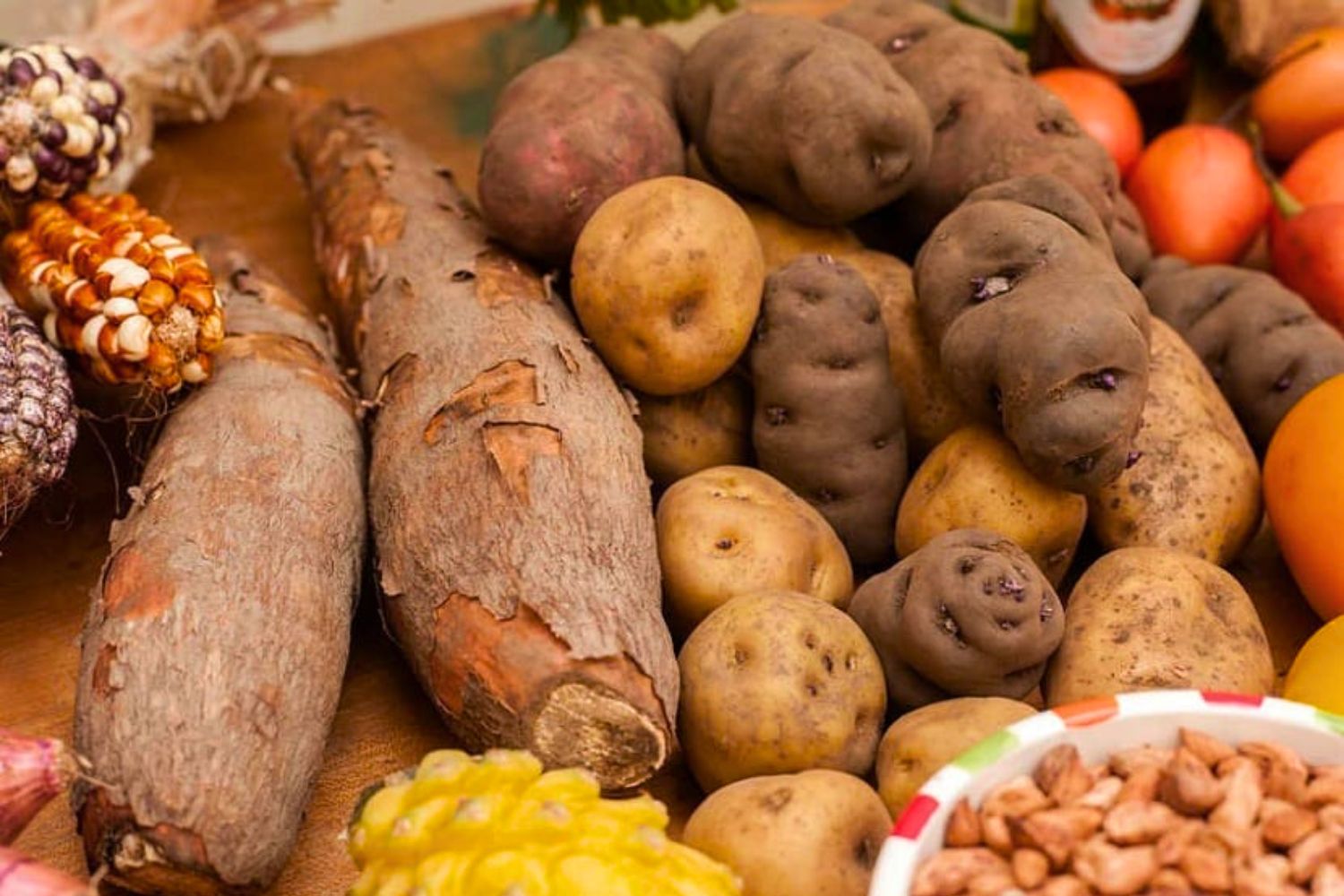
From the beginning of the Spanish presence, new culinary uses and customs were incorporated with the beginning of the viceroyalty. The frying, the use of dairy products (incorporated into some chupes or soups), in addition to beef, pork, chicken eggs and new poultry; In addition, some crops arrived that would be essential for the new cuisine, such as onion and garlic, which, combined with chili peppers, would be the main ingredients of many Peruvian dishes.
The lime brought by the Spaniards and adapted over time to the Peruvian land, gradually transformed into the current Peruvian variety called lemon (subtle), green, small and acidic in color and which becomes one of the basic components of cebiche. The vine (from which pisco originates) and the wines also arrive at the beginning of this period. In the first encounters between the Spanish and the natives, during the conquest of the Inca empire, they exchanged the pieces of fried Iberian pork with potatoes, sweet potatoes and indigenous corn.
Francisco Pizarro, who raised pigs in his childhood, was the main fan of this dish called chicharrón during the early days of the Spanish presence in this territory. The dedication of many nunneries to cooking in an environment where sugar plantations (a species also brought by the Spanish) and immense varieties of native fruits abounded also originated a long pastry tradition, standing out the alfajor, manna prepared in different varieties , shapes and colors according to the occasion, as well as dozens of other desserts of the time.
The African slaves contributed their own in a series of stews, in addition to the use of the entrails discarded by the elites, which they seasoned abundantly to reduce the strong flavors of the meat and cooked on the embers. Many of the most representative dishes of current Creole food came from here, such as: anticuchos, sangrecita, sweet potato with stuffing, cau cau, tummy, rachi, sweetbreads, chanfainita, patita con peanut, choncholí and tacu-tacu.
The Peruvian anthropologist Humberto Rodríguez Pastor highlights the type of traditional Peruvian tamale as an Afro-Peruvian legacy in his work “Life in the environment of the Peruvian tamale”. The mentioned food is introduced in this territory from the first years of the Spanish presence that came with its African slaves. The large number of them from the African Atlantic coast marked the city of kings demographically, since in the 17th century, more than 60% of the capital’s population was of African origin.
Photo: Anticuchos.
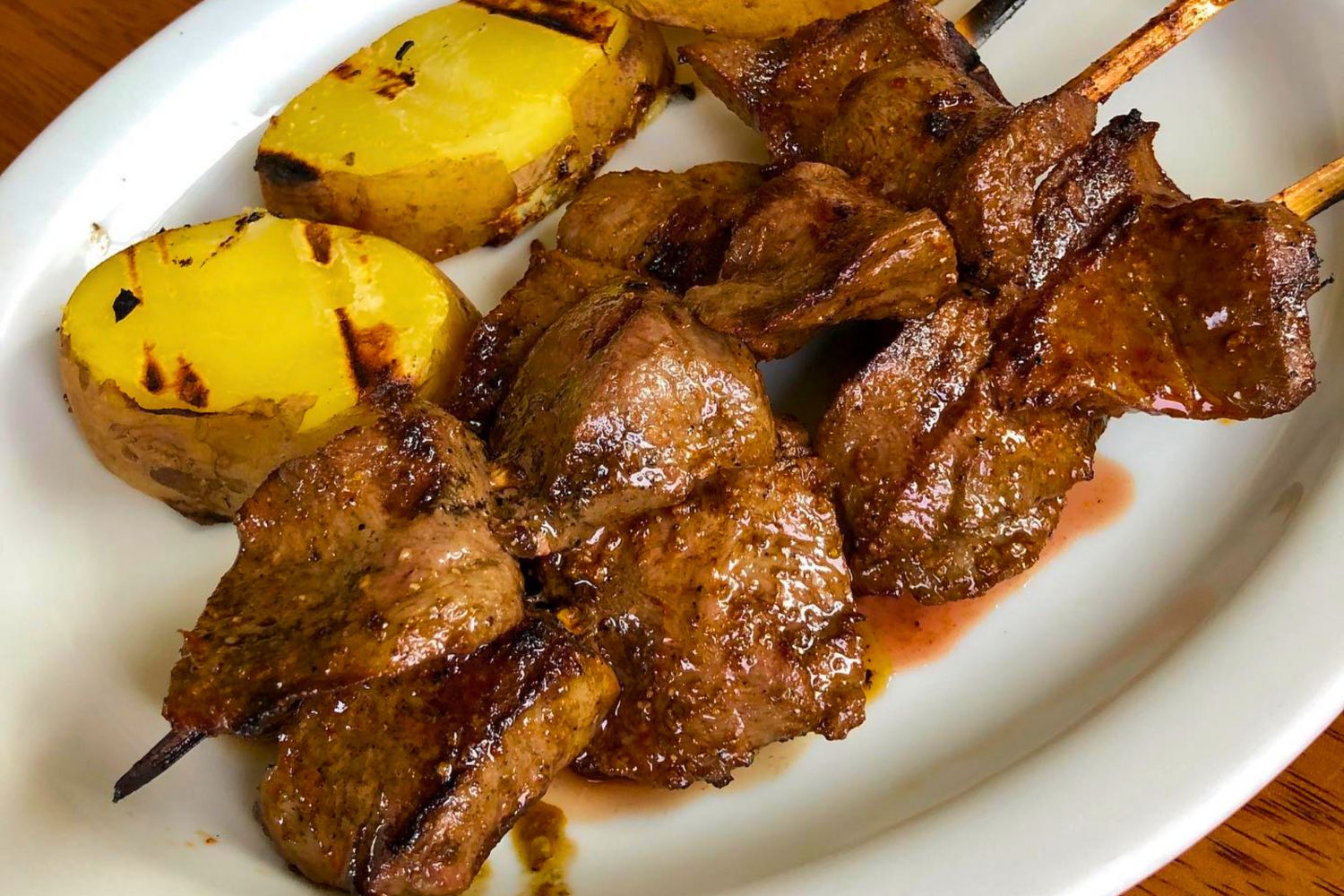
After independence there was a series of migrations from different origins that integrated their own traditions into the already local culinary dynamics. The migration of the Chinese-Cantonese in the mid-19th century popularized sautéing over high heat and sweet and sour flavors in meats, as well as the use of new herbs and soy sauce. But his most notable contribution was rice. Although it was already consumed since the 16th century, it was after the Chinese migration that rice became popular and became the quintessential Peruvian garnish.
The favorite form of rice in Peru is arroz graneado not overcooked, it is made with long grain rice, however, it differed from the Chinese preparation in the use of garlic and salt. Another no less influential immigration in the second half of the 19th century is the Italian, which popularized the use of pasta, chard cake, sweets and desserts such as panettone, which is a must at Christmas throughout the country. Finally, the Japanese migration at the end of the 19th century had a notable impact on Peruvian seafood cuisine, giving rise to the so-called Nikkei cuisine. Very neat Japanese cuts and techniques in the presentation of the dishes, join Peruvian sauces and preparations and a new culinary aspect is born in Peru. Thus, for example, from the crossing of Japanese sashimi and Peruvian cebiche, the tiradito was born.
Photo: Tiradito.
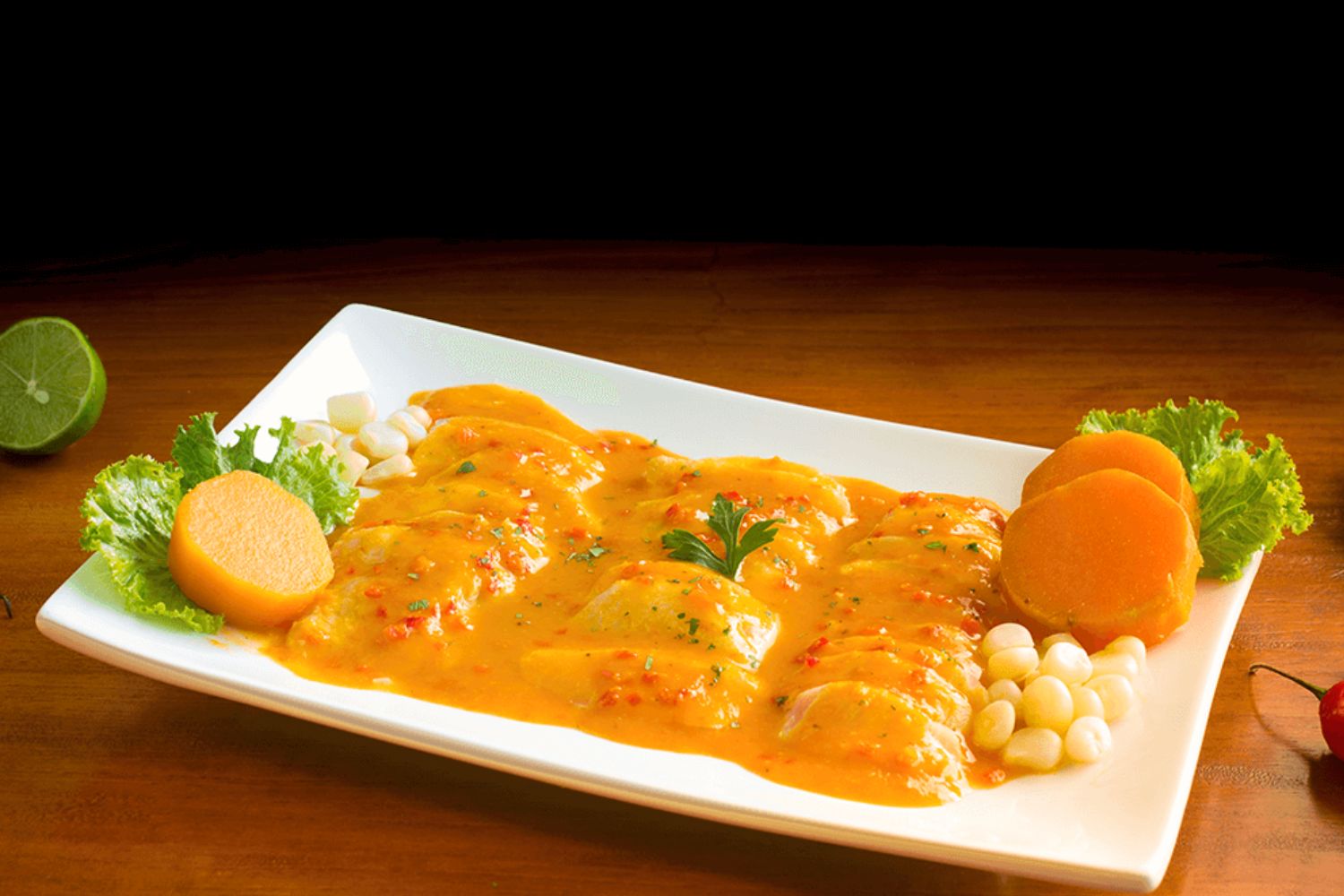
The country’s gastronomy is registered as a world brand, and therefore as a flagship product of Peru. Due to this rich variety, its flavor and the foods used, Peruvian gastronomy is constantly awarded internationally and its chefs often obtain international medals that distinguish them. A notable element is its constant openness to innovations and the continuous development of new dishes, incorporating into gastronomy the continuous search for experimentation and the avant-garde.
Just as each region preserves its culinary richness, in haute cuisine the mixture of colors and food products stands out, a sample of this is the so-called Novoandina cuisine, a new culinary style that emerged in Peru due to the interest of local gourmets to resume food customs from the pre-Hispanic past to recreate them, thus rescuing and revaluing many of the native ingredients.
Peruvian cuisine has been the meeting point of various cultures, thanks to the inclination for miscegenation that has characterized the history of Peru. Classic Peruvian cuisine is usually attractive for its color and sometimes for its spicy nuance due to the different varieties of chili, this being a gravitating ingredient. However, some peppers are not spicy and only serve to give color to the presentation of typical dishes or to give them more flavor. Rice is a food that accompanies many dishes in the country’s gastronomy, popularized mainly from the 19th century, although in fact it became a key ingredient that goes beyond a simple garnish, since there are many dishes made from rice.
Photo: Different varieties of chili sauce.

The variety of ingredients that exist in the territory (both native and those that arrived from other latitudes) allowed the evolution of a diverse cuisine, where strong regional traditions and a permanent reinvention of dishes coexist, without opposing each other. Peru is considered one of the largest genetic centers in the world and many ingredients of ancestral origin are used in its cuisine:
∙ Potato: Peru has the largest variety of potatoes in the world, more than 3,500. More than 700,000 families earn a living from this crop.
The international potato center is based in Lima, from which new varieties of this tuber have been registered.
∙ Sweet Potato: There are 150 varieties.
∙ Ají: Originally from Peru and Mexico, spread throughout the world mainly by Spanish and Portuguese sailors, due to its vitamin value that protected them from scurvy. The most commonly used varieties around the world, however, are derived from Mexico and Central America. Peruvian chili peppers are virtually unknown outside of the Andean region of South America. Aji amarillo, ají limo, ají mochero, ají panca and rocoto are cultivated almost exclusively in Peru.
∙ Tomato: The most recent investigations seem to indicate that the origin of the tomato was in the current Peruvian territory and in any case, it would be a parallel domestication plant in Peru and Mexico (from where it took its name).
∙ Fruits: There are more than 500 species originating from the current Peruvian territory. Like some of these: Peruvian Lemon and Pineapple.
∙ Chirimoya: Of Peruvian origin, it is a green-skinned fruit with a juicy white pulp, with a peculiar aroma and sweet flavor.
∙ Lucuma: It is also with the custard apple, perhaps one of the most extraordinary fruits in Peru, it has a very intense flavor and aroma and has been a component of many sweets and soft drinks since ancient times.
∙ Annatto: It is a seed of a fruit original to Peru and Mesoamerica, it has a reddish tint that is used as a food flavoring and as a natural cosmetic tincture throughout the world.
∙ Fish: There are 2000 species of fish, marine, lake and river, holding the first place in the world in terms of varieties.
∙ Tarwi: It is a very high protein vegetable.
∙ Maize: There are 50 ecotypes, sharing its origin with all of Central America. It originally arrived in Europe as a supplement for cattle feed and later, in various forms and ways, became indispensable on the tables of the world. The varieties used in Europe and most of the world, however, are from Central America. The corn from Peru with very large grains is a component of numerous traditional dishes, as well as a variety: Purple corn is unique in the world.
There are many other ancestral crops of growing popularity and avant-garde use (for example in astronaut nutrition), such as unique cereals such as quinoa, kañiwa and kiwicha. In Peru, you can also find native Andean and Amazonian edibles such as golden gooseberry, elderberry, camu camu (contains high levels of vitamin C) or vacón (highly recommended for diabetics) and cat’s claw (well known for its cancer healing properties).

This has three main axes: the Coast, the Sierra and the Jungle.
It is made up of a variety of dishes and species in which we have:
The marine kitchen
Peru is one of the two main producers and exporters of fishmeal for animal feed in the world. Its richness in fish, its fauna and marine flora are enormous, finding types of animals or plants that only occur in its waters. But we must also highlight its riches of fresh water that are found mainly in the Amazon River and its tributaries, as well as in its lakes, such as Titicaca.
Each coastal region, different in fauna and flora, adapts its cuisine according to the products of its waters. The shrimp chupe is an original and typical dish from the department of Arequipa, it is one of the most refined dishes of the Peruvian coast. It is a thick soup based on fish and shrimp, potatoes, milk and chili. In Peru there are different varieties of chupes, such as chupe de habas, chupe de zapallo, chupe de olluquito, among others. Other typical dishes of this kitchen are ceviche, mussels a la chalaca, tiradito, leche de tigre, parihuela and pickled fish.
Creole cuisine
With 250 traditional desserts since the 19th century, this great variety has originated mainly in coastal cities since the time of the Viceroyalty of Peru, such as suspiro de lima, ranfañote, picarones, doña pepa nougat, melcocha and purple dungeon, among others. In Tacna, at the beginning of the 20th century, its main dish, spicy a la tacneña, was created. Restaurants with Creole menus in their various forms are numerous, pastry shops abound and constitute one of the culinary riches of the cities of Lima, Arequipa, Ica, Trujillo and Tacna.
On the other hand, there is a very popular hybrid dish on the country’s coast, especially in the central area, simply called “combined”. It consists of a portion of huancaína potatoes with traditionally stewed noodles (carrot, tomato and onion dressing) and cebiche. It should be added that combined can be said to any dish that turns out to be a bit of other dishes; so the term combo does not necessarily apply to the dish described above.
The dry kid, is another typical dish of Peru, it was born in the north of the country between Trujillo and Chiclayo, it is a mammal the size of the lamb, also known as goat, which is macerated with different seasonings including yellow chili, chicha de jora and cilantro are also added, served with rice and beans. Other northern dishes are shámbar (served only on Mondays), theologian soup, pepián, causa en lapa, fried guinea pig with ajiaco, fried Trujillo, etc. All exclusive to Trujillana cuisine.
Photo: Mussels to the chalaca.
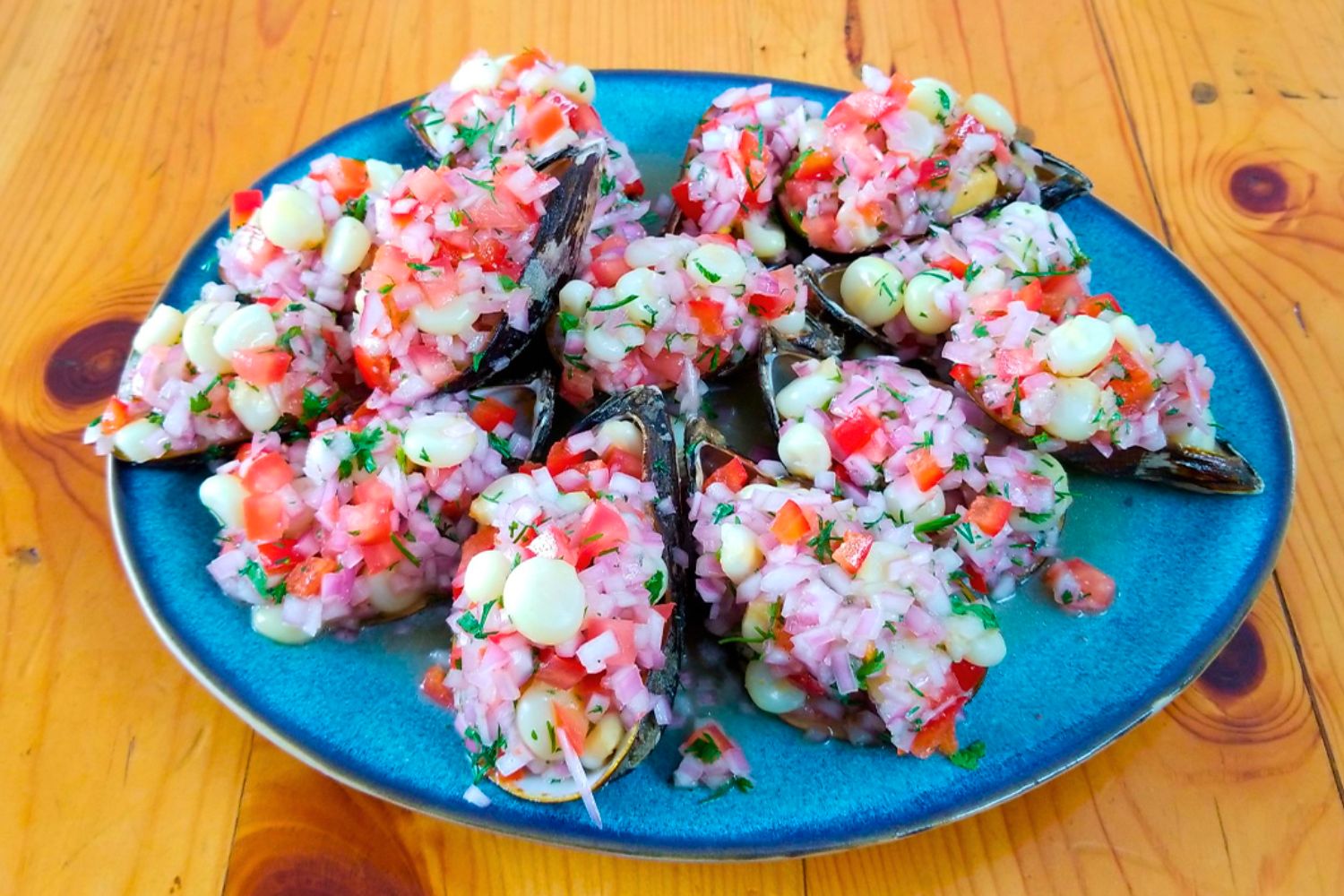
The Andes are the origin of ancient cultures and with them the flavor of Peruvian cuisine. In this high part of the country, the main diet continues to be corn, potatoes and a multiplicity of tubers. Introduced products such as rice, bread and pasta are now also popular. The variety of meats consumed has been enriched with bovine, porcine and ovine; In very high places like Huancavelica, llama, alpaca and wild animal meat is still consumed.
The variety and richness of Andean food is similar to that of coastal food. From the chactado guinea pig to the moron soup and from the huancaína potato to the chairo soup, to more than highly original desserts and grains that are eaten fresh or cooked in various ways. The head broth and the golden mutton ribs are a minimal sample of a vast catalog that has hardly been disseminated.
Some of the main Andean dishes are: pachamanca, tarwi stew, stuffed rocoto, Arequipeño adobo, malaya, spicy puca, olluquito with charqui, huatia, huancaína potato, ocopa and dishes made with coy . Likewise, a great variety of freshwater fish is part of the regional gastronomy, with trout being highly appreciated, introduced at the end of the 19th century.
Photo: Pachamanca.
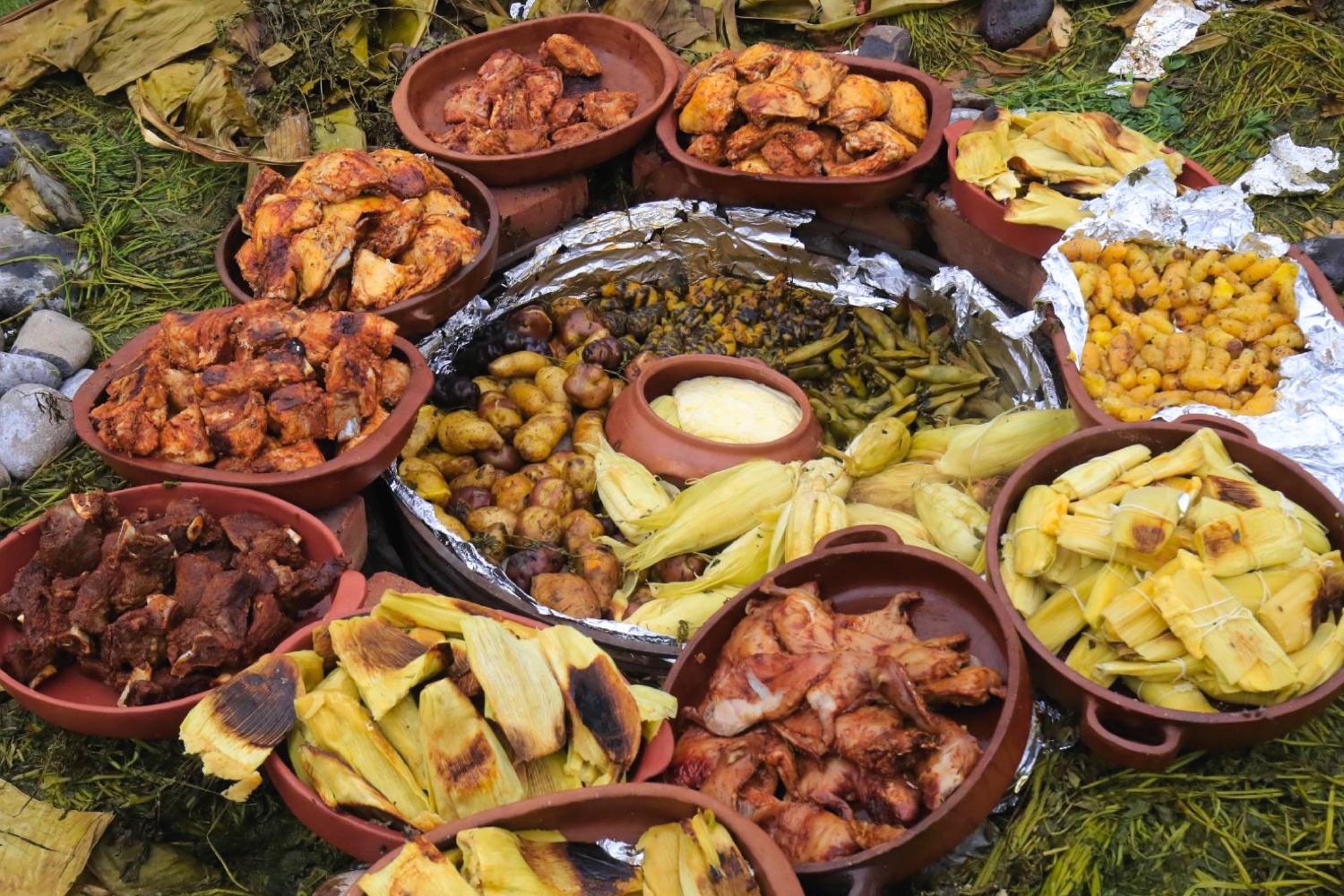
The jungle area of Peru has a great biodiversity in funa, which is why it is traditional to consume various meats such as huangana (wild pig), suri, tapir, rodents (majaz, añuje, punchana, sachacuy), armadillo, turtle , woolly and maquisapa monkeys. In the immense variety, the paiche stands out, the second largest freshwater fish (it can weigh up to 180 kilos and measure up to 3 meters long).
The food of the Peruvian jungle has as popular elements, among others, a basic dressing that is known as misto (or mishkina), the use of ingiri, which is how the boiled green plantain is known, the high consumption of fruits and the cooking of meats, especially fish and also juane, wrapped in bijao leaves, a palm tree that has a particular aroma. With respect to meat, they are usually contributed by hunting and fishing and to a lesser extent by livestock.
With respect to fruits, camu camu stands out, which concentrates the greatest amount of vitamin C. Aguaje is also widely consumed, from which a soft drink called aguajina is prepared, with a high content of vitamin A. However, tropical fruits abound like mango, pineapple and many others. A soft drink known as chapo is prepared from the ripe banana.
An important element of the food in the jungle are liquors, mostly the product of the fermentation of cane liquor with local species (roots, fruits, among others). For example, the chuchuhuasi, the uvachado, the seven roots, the rompe calzón, among others. The masato deserves a special mention, a drink of pre-Hispanic origins made from chewed cassava and fermented for a few days in an artisanal earthenware container with a wide base and narrow neck. The best-known dishes of the Peruvian Amazon are juane and tacacho with cecina but there are also others of high consumption such as inchicapi, patarashca, chonta salad, timbuche, paiche ceviche, charapita chili sauce, chili pepper cocona, suri, charapita rice, etc.
Photo 1: Juane. Photo 2: Tacacho with jerky. Photo 3: Tamale. Photo 4: Patarashca.

The traditional confectionery of Peru began in colonial times, at this stage the introduction of sugarcane cultivation, European customs and the presence of African slaves were decisive.
∙ Alfajor: It is a dessert of colonial origin that is made up of two cookies joined by a sweet filling, usually manjar blanco.
∙ Rice pudding: it is a dessert of colonial origin with Arab-Spanish influence and widely consumed. For a few years the habit of serving it together with the autochthonous purple mazamorra has been acquired, calling this dish “combined”.
∙ Zambito rice: It is very similar to rice pudding, only that chancaca is included in its preparation.
∙ Api: Mazamorra colada, made of purple corn, sugar, cinnamon, cloves, and lemon are added.
∙ Chumbeque: It is the northern nougat consumed for centuries and that identifies Piura. It is made with flour, egg yolks, sesame, vegetable shortening, cinnamon, anise, whose layered baked dough is joined with fruit honey. It has the property of maintaining its smooth consistency and flavor for a long time.
∙ Strained beans: It is a sweet dough made from beans in the valley of the province of Cañete (Lima) and in the area of Chincha Alta in Ica. It is spread on bread and also consumed directly. It is accompanied with toasted sesame seeds.
∙ Humita: Prepared with corn dough wrapped in dry corn husk.
∙ King kong de manjar blanco: It is a Lambayecan dessert prepared with cookies made of flour, butter, egg yolks and milk, which are combined with manjar blanco, pineapple candy and peanut candy. Its origin is in the 1930s, where it would have taken its name when its large size was compared with that of the gorilla King Kong, whose movie was released at that time. It is currently an export product.
∙ Mazamorra de cochino: It is a dessert that dates back to colonial times, although its origins are not exactly defined. It is made of cornmeal, chancaca, pork or pork butter (it is from this ingredient that it derives its name because the pig is also called “cochino”), cloves and anise.
∙ Mazamorra morada: It is a typical dessert made from purple corn. Cinnamon is sprinkled for presentation.
∙ Custard from Piurana: It is a dessert of Piura and Lambayeque origin made with milk and chancaca, having a result similar to a light and sugary toffee.
∙ Picarones: It is a dish that serves fried rings made with a mixture of sweet potato flour and pumpkin pieces, bathed in chancaca honey. It is a traditional Lima dessert, its street sale predominates and it is very popular nationwide. Pancho Fierro and Ricardo Palma included the “picaronera”, the woman in charge of preparing this stew, in their testimonies at the time.
∙ Weights: It is an old Lima dessert that consists of a thin flour dough that is fried and sweetened with manjar blanco or jam.
∙ Ranfañote: It is a sweet from Lima originated in colonial times. It consists of pieces of bread dipped in chancaca honey.
∙ Suspiro a la Lima: It is an old Lima dessert consisting of a layer of yolk white delicacy, covered by a fresh and loose meringue made with Porto (sweet wine) and sprinkled with cinnamon. It is usually served in a glass.
∙ Teja: It is a sweet from Ica with Arab influence that consists of a sugary white dough filled with manjar blanco and dried fruits such as pecans, sweet lemon peel and cherries. From this dessert the chocoteja was born, which is similar to the tile, except that the coating is made of chocolate.
∙ Ice cream cake: It is a cake made up of three layers: the upper layer of strawberry jelly, the middle layer of strawberry jelly whipped with milk, and the lower layer of sponge cake. It has been known since the 1960s.
∙ Nougat of Doña Pepa: It is a Lima sweet widely consumed during the month of October, when the festival of the Lord of Miracles takes place. Its creation is attributed to Josefa Marmanillo, a slave living in the Cañete valley, recognized for being a good cook and devoted to the Christ of Pachacamilla.
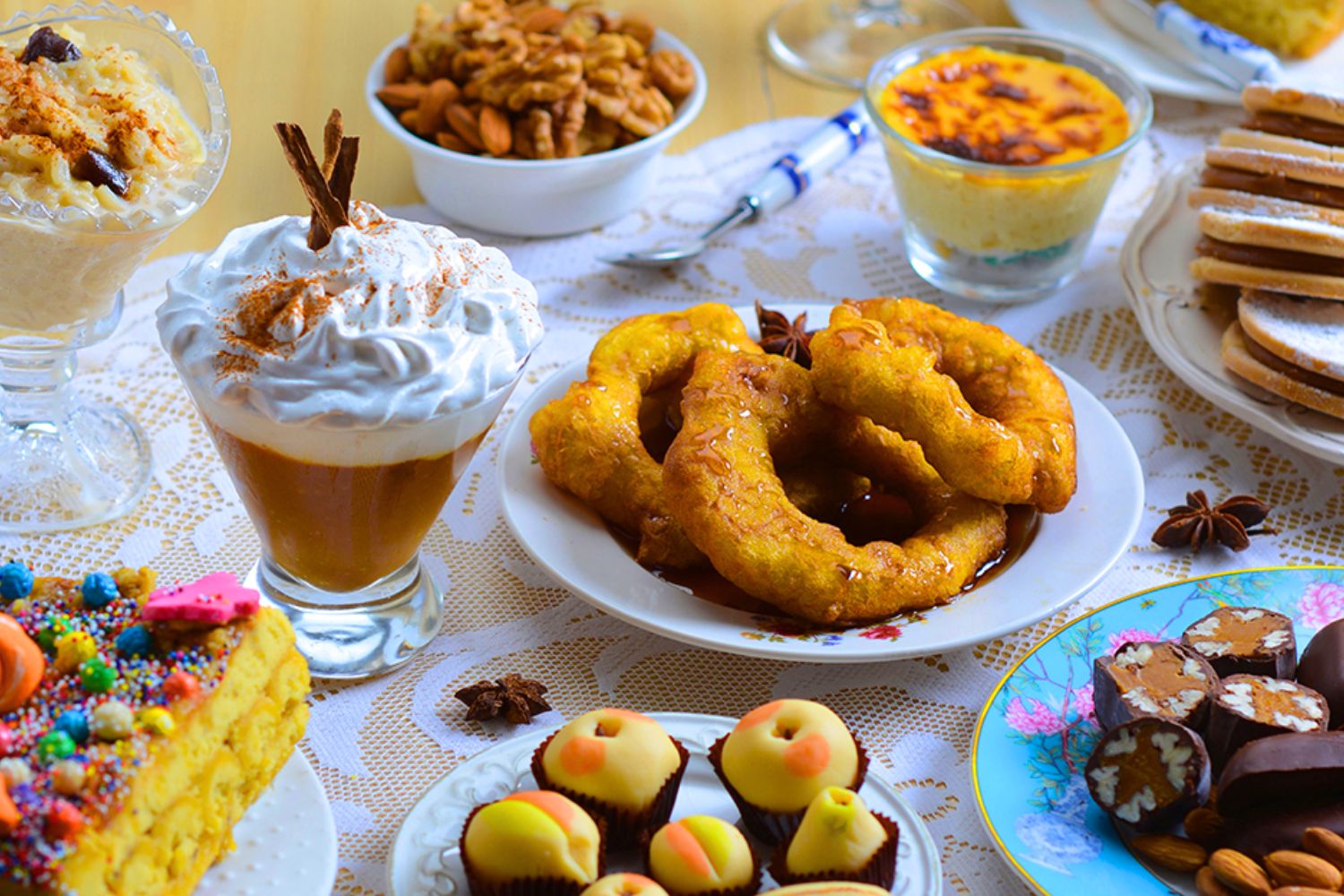
Coffee: Peru is the largest producer of organic coffee in the world.
Soft drinks, soft drinks and infusions
∙ Soft drinks: The Inca Kola and the Scottish Kola in Arequipa stand out, both have a tradition in accompanying local food. Inca Kola, the best known inside and outside the country, is the only soft drink in the world that has managed to outsell Coca Cola in a local market. Kola Escocesa is a drink made with mineral water from the town of Yura in the department of Arequipa, where it is considered the quintessential drink of that region and an undisputed companion to the varied Arequipa gastronomy. Other soft drinks that stand out are the Kola Inglesa, the Kola Real and the Triple Kola.
∙ Chicha morada: It is a drink prepared with boiled purple corn, to which once cold, add pieces of pineapple, drops of lemon, sugar and ice to taste. Currently there are packaged versions of this soft drink produced by transnational companies.
∙ Cremolada: It is a derivative of fruit juices, similar to sorbet, which is prepared by freezing the juice until it forms ice, then gently crushing it to form a semi-solid mass that is served in glasses. It is popular in the summer times. A similar preparation is raspadilla.
∙ Infusions: Coca tea is an infusion that is consumed nationwide, it is traditional in the Andean zone, where it is used to counteract dizziness and altitude sickness. Another traditional infusion is the so-called linden tea, which is used as a sedative and also, in popular culture, as relief to combat fright, anger and curses; Likewise, cat’s claw tea stands out, which is a drink prepared with a plant from the Amazon, cat’s claw, known for its medicinal and healing properties. Another popular drink is the emollient, it is a drink that is prepared on the basis of roasted barley grains, extracts of medicinal herbs, sugar and lemon juice. It has a low nutritional content, although it can provide some carbohydrates, minerals and vitamin C to the diet. Its best value is medicinal.
∙ Juices: Due to the diversity of fruits, it is common for there to be a wide variety of fruit juices. For example, cocona, camu camu, aguajina (aguaje-based soft drink), among others.
∙ Tea: In Peru they make tea with the shells of cocoa beans.
Photo: Chicha morada.

∙ Cachina: It is the result of early fermentation of grape juice. It is very popular at harvest time, which is celebrated in the department of Ica.
∙ Chicha de jora: Chicha from Peru presents many varieties. The traditional form, known as chicha de jora, has been prepared since the time of the Incas; It is made by fermenting germinated corn, called Jora, and different fruits and aromatic spices. In Quechua it is known as ajha or acca and it is stored in clay containers known as chombas. The chicha de jora is a widespread drink in a good part of the Peruvian territory.
∙ Chicha de güiñapo: This particular variety of chicha is widely consumed in the city of Arequipa. Like chicha de jora, chicha de guiñapo is made with a sprouted and dried grain of corn. However, for the preparation of this, the same variety of corn used in chicha de jora is not used. A specific variety of black corn is used, which has been domesticated and is native to the valleys of Characato and Socabaya. This variety of corn gives this chicha a vivid crimson coloration.
∙ Masato: It is an ancestral drink from the Peruvian jungle, and from the South American jungle in general. It is made with the fermentation of cassava.
∙ Pisco: Pisco is the national drink of Peru. This liquor comes from the grape of eight local varieties: the quebrante grape, the Uvina grape, the Mollar grape, the Negra Criolla grape, the Italia grape, the Albilla grape, the Moscatel grape and the Torontel grape; It is produced in some regions of the country. There are four varieties of Peruvian pisco: Pure, Mosto verde, Acholado and Aromatic. Based on pisco and lime, the famous pisco sour is prepared. Other traditional cocktails made with pisco are the algarrobina cocktail, the libertadores punch, the pisco punch, the tacna sour and the chilcano.
Photo: Pisco sour.
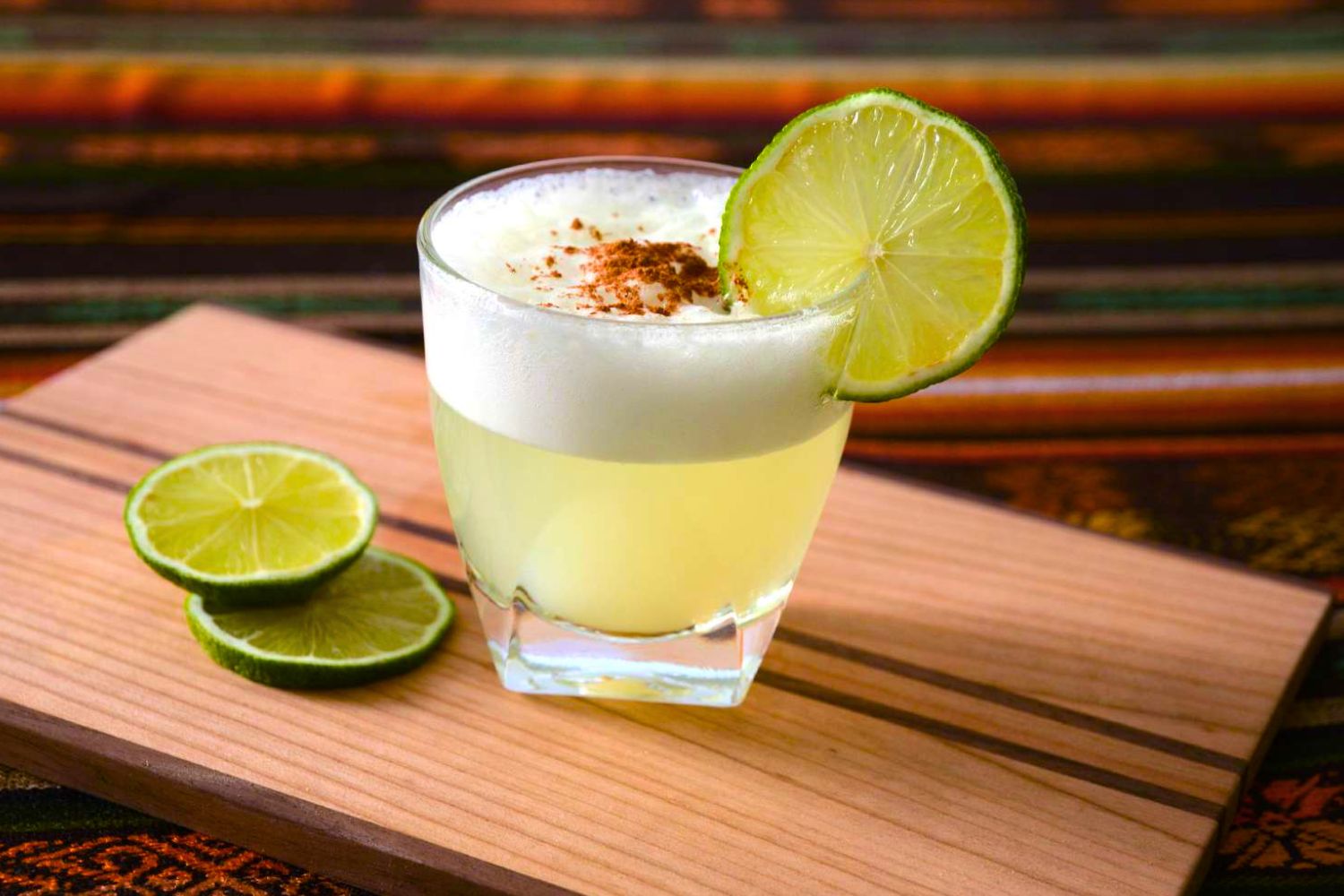
Since the end of the 20th century and the beginning of the 21st century, ceviche, grilled chicken and chifa dishes have been the most popular representatives of Peruvian food, being widely consumed throughout the Peruvian territory and there are versions for all social classes: from very cheap preparations that are consumed “on the go” to very exclusive gourmet preparations.
Ceviche, cebiche, seviche or sebiche, is a widely spread dish and declared Cultural Heritage of the Nation by the Peruvian government. The basic recipe for ceviche is the same in all regions: fish in pieces, lemon juice, red onion, chili pepper and salt to taste. The fish used are very diverse and include both freshwater and sea species, as well as other seafood such as shellfish and seaweed and even vegetables. The dish is accompanied by local products such as cancha serrana, sweet potato, chifles, zarandaja, cassava and lettuce leaves.
Photo: Ceviche.
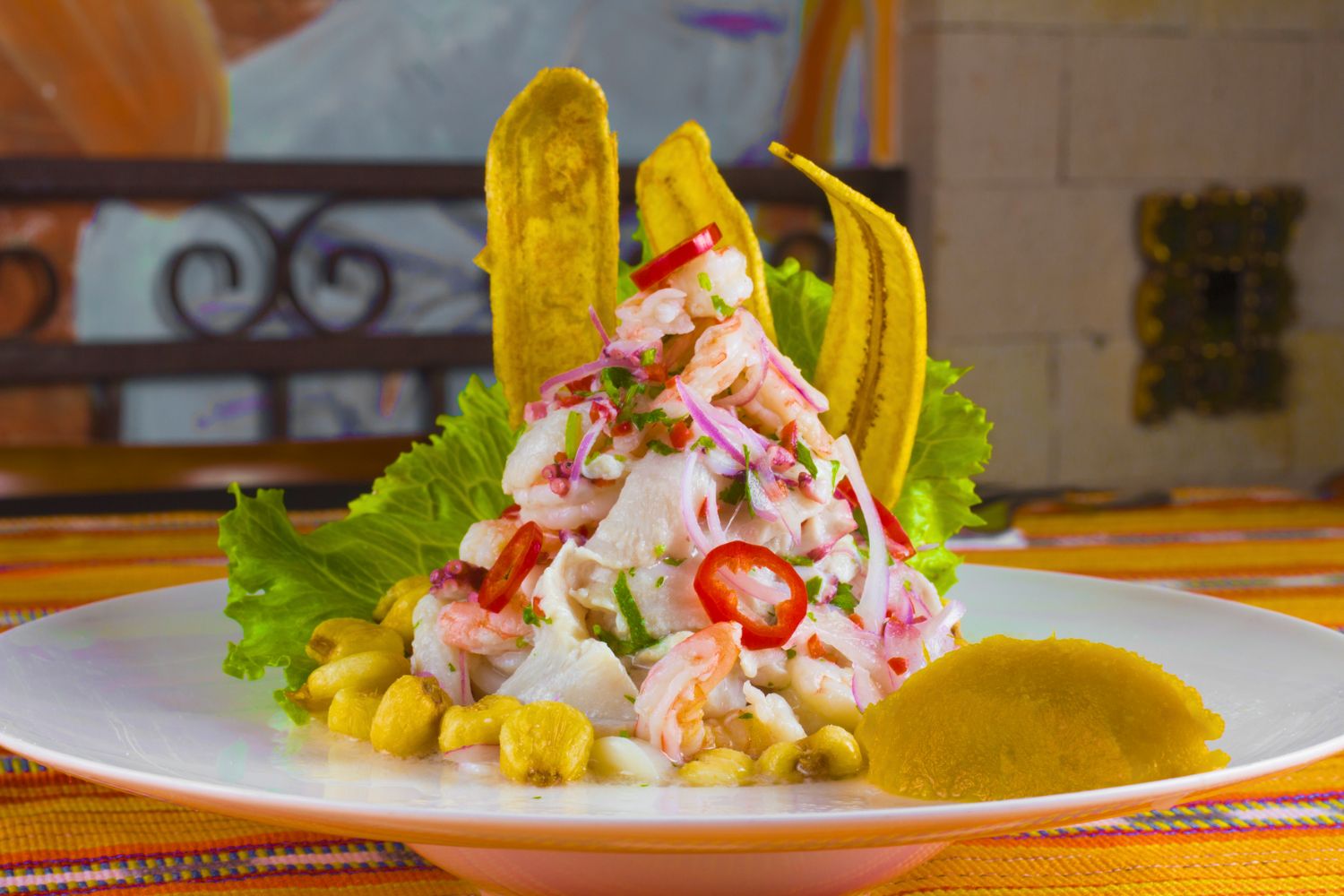
Chifa is a term used in Peru to refer to the cuisine that arose from the cultural adaptation of the gastronomy of Chinese immigrants, mainly from the Canton area, who arrived on the Peruvian coast in the mid-19th century and early 20th century. This term is also used to refer to chifa restaurants where this food is served. The main dishes are chaufa rice, wonton soup, salted noodles, airport and chijaukai chicken. Although Chifa is not part of traditional Peruvian food, Chinese migration made this culinary style popular.
Photo: Chifa.
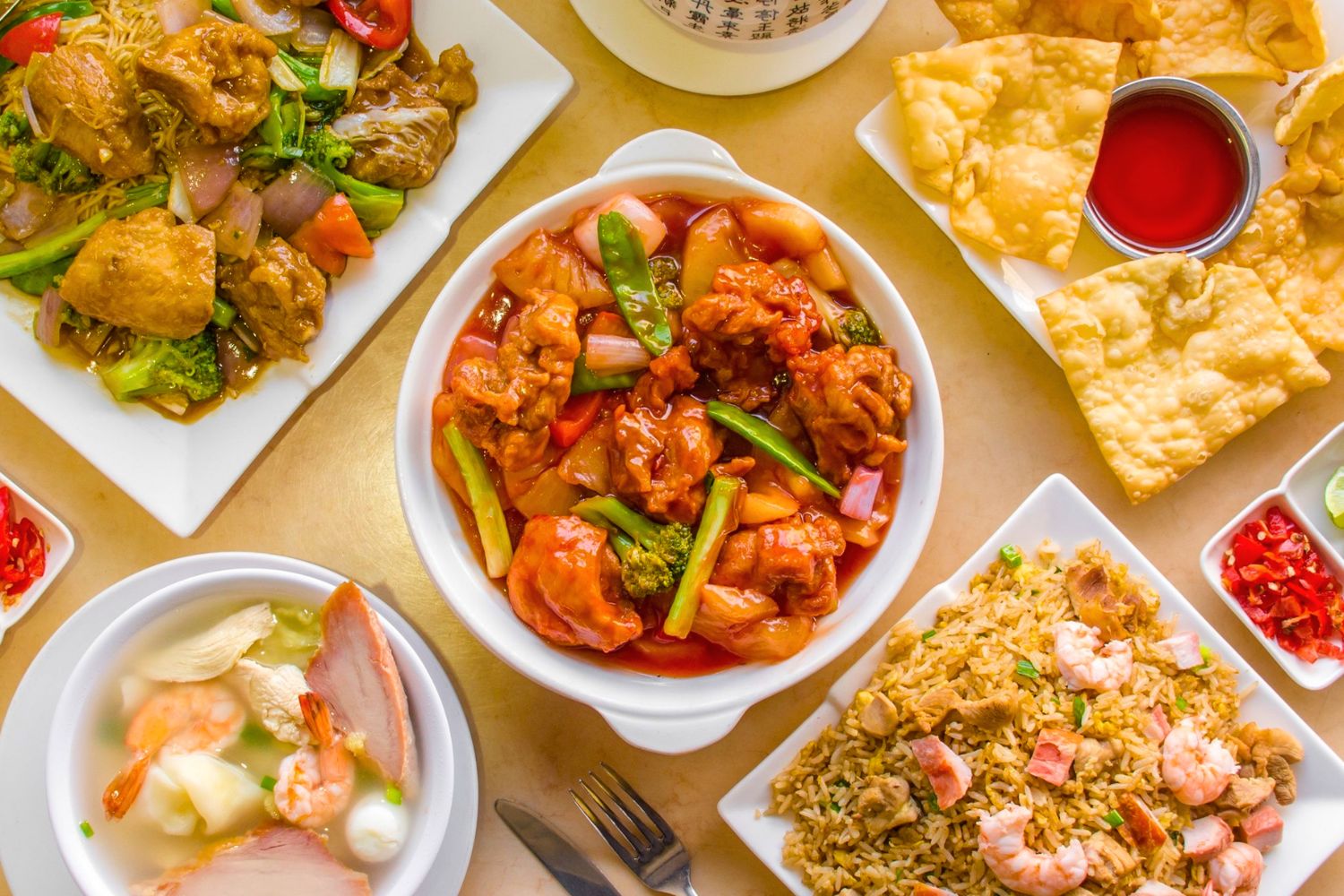
It is one of the most consumed dishes in the country. It has been recognized as a “Peruvian Culinary Specialty” by the Peruvian government on October 14, 2004. It basically consists of a macerated eviscerated chicken, in a marinade that includes various ingredients, baked on coals. The beginnings of this dish in Peru can be traced to the Ate district of Lima, its creator was the Swiss Roger Schuler, a chicken farmer and founder of the restaurant La farma azul.
In 1950 Schuler, together with Franz Ulrich, invented and registered the patent for the machine for cooking grilled chicken, a mechanical system of planetary rotation that makes the chickens rotate on their own axis and alter their circular motion simultaneously. In Peru the dish is accompanied by French fries, salad, various creams and chili sauces of all kinds; In the jungle of Peru, fries are often replaced by fried plantains.
Photo: Grilled chicken.
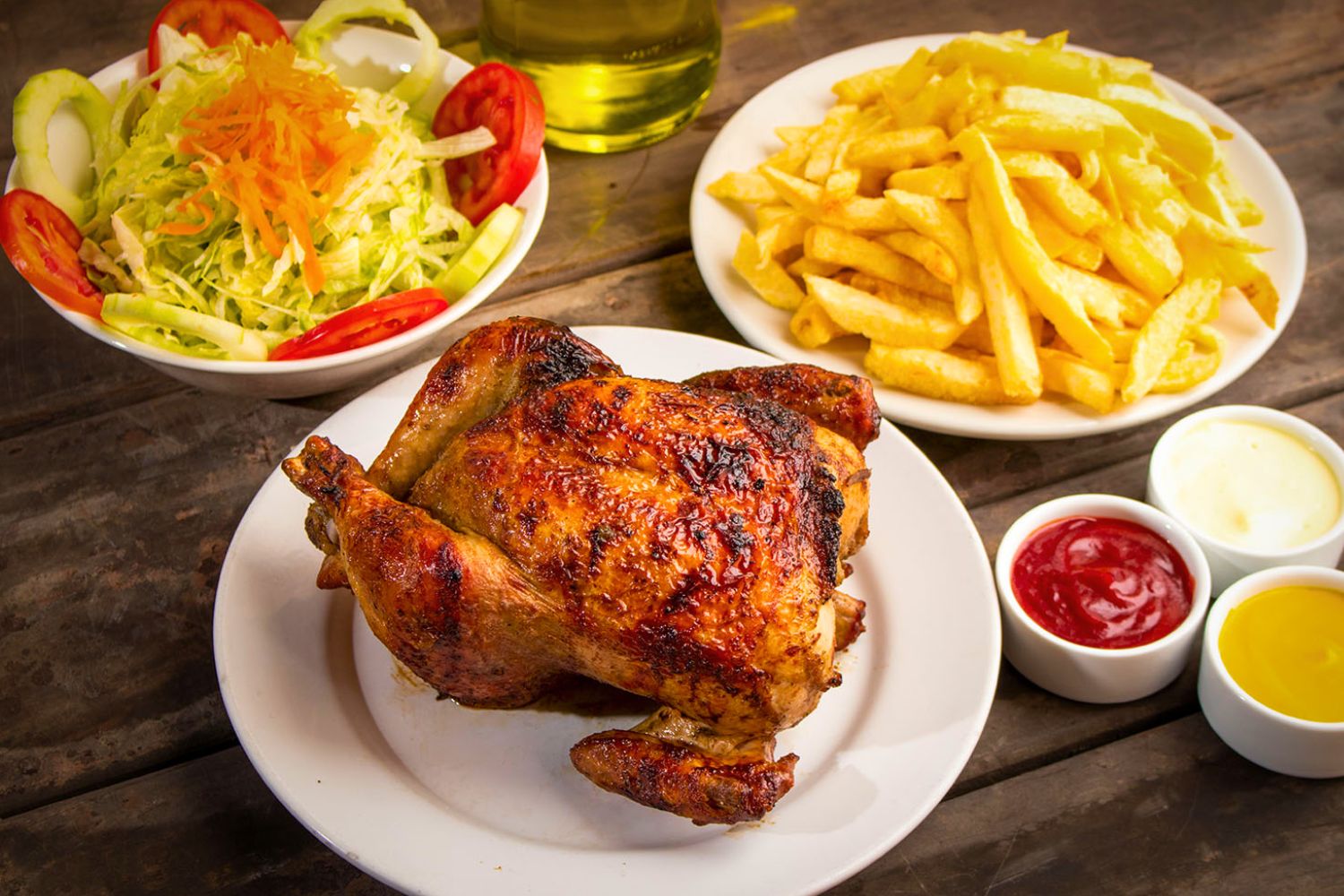

Enjoy an incredible vacation, in the heart of the Inca empire, Cusco, our travel program will take you to the most famous tourist attractions of Cusco, such as the Sacred Valley of the Incas, Machu Picchu, in very cozy hotels.


Ausangate Trek & Rainbow Mountain, Explore this route of turquoise lakes, imposing snow-capped mountains, little-visited trails and Very experienced trekking guides.
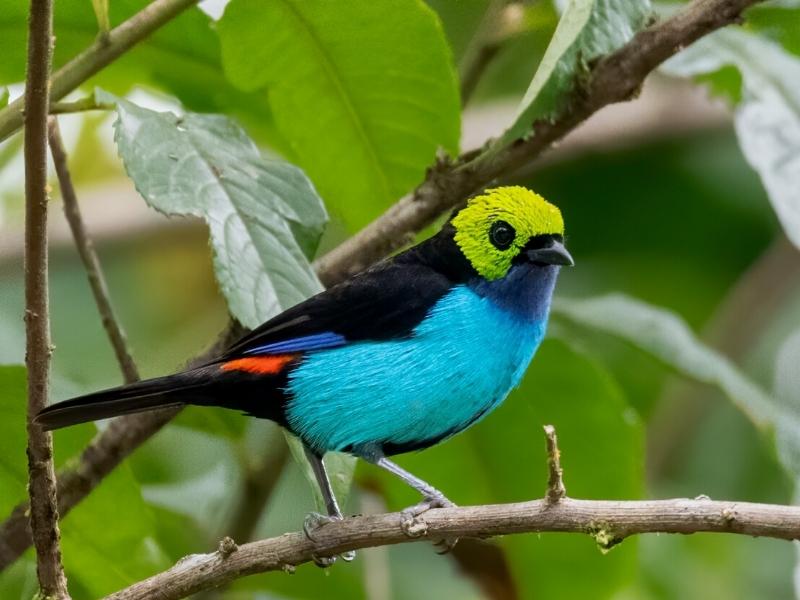
Manu National Park is located in the Amazon rainforest of Peru. This attraction is one of the few places on the planet that still maintains its great biodiversity of birds, mammals, reptiles and many medicinal plants.
